- ABOUT JNU
- ADMISSION
-
ACADEMICS
- Schools and Colleges
-
Departments and Programs
- Arts College of
- Chinese Language and Culture College of
- Economics College of
- Electrical and Information Engineering College of
- Foreign Studies College of
- Information Science and Technology College of
- Environment School of
- Humanities School of
- International Business School
- International Studies School of
- Journalism and Communication College of
- Law School
- Liberal Arts College of
- Life Science and Technology College of
- Management School of
- Marxism School of
- Medicine School of
- Pharmacy College of
- Physical Education School of
- Science and Engineering College of
- Shenzhen Tourism College
- Research Institute
- Research Center
- Programs in English
- Majors
- Study Abroad
- Online Learning
- RESEARCH
- CAMPUS LIFE
- JOIN US
Latest News
Fiber Optic Drug Delivery and Light-Controlled Release: A New Hope for Tumor Chemotherapy
Publisher: China Science Daily
Date: November 14, 2024
Chemotherapy remains a cornerstone in cancer treatment, but it faces significant challenges such as poor drug delivery efficiency, systemic toxicity, and the absence of effective pharmacokinetic monitoring. To tackle these issues, a research team led by Professors Guan Baiou and Ran Yang from Jinan University has developed an innovative approach that utilizes optical fibers for targeted drug delivery to tumors. Their findings were published in Light: Science and Applications in September 2024.
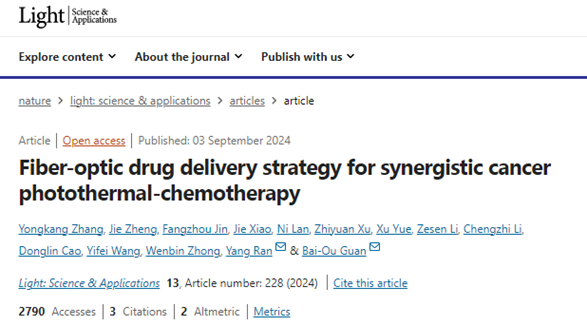
(Screenshot of the paper)
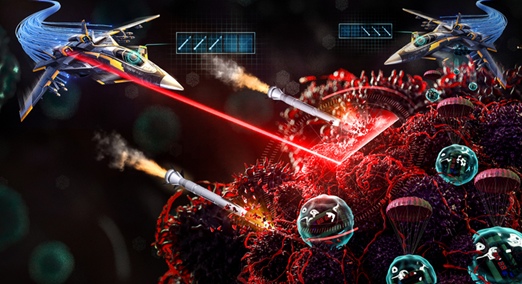
(Schematic diagram illustrating the concept of precise tumor targeting via fiber optic-controlled drug release.)
The Challenge of Traditional Chemotherapy
Every year, over 10 million people die from cancer globally, with projections indicating this number could rise to 16 million by 2040. Traditional chemotherapy methods involve administering anti-tumor drugs via oral or intravenous routes, which can lead to significant side effects due to the systemic circulation of these drugs, affecting healthy tissues and organs. The low targeting efficiency of these methods also results in treatment recurrence and limited efficacy.
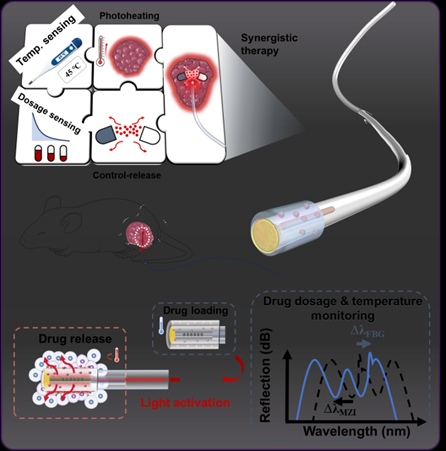
(Schematic diagram of a tumor photothermal chemotherapy strategy that synergizes with fiber optic-controlled drug release.)
A Novel Solution: Fiber Optic Drug Delivery
The research team has proposed a fiber optic drug delivery and light-controlled release system that directly delivers chemotherapy drugs to deep tumor lesions. This method not only enhances the precision of drug delivery but also integrates photothermal therapy, which uses heat to improve drug absorption by tumor tissues.
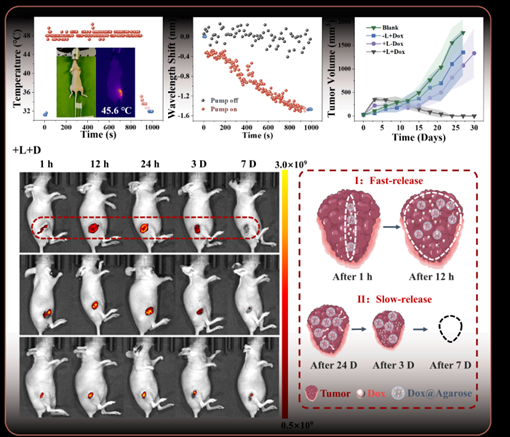
(In vivo experiments and investigation of treatment mechanisms for multifunctional tumor therapy probes utilizing optical fibers.)
Key Features of the Fiber Optic System:
1. Direct Delivery: Optical fibers serve as carriers for chemotherapy drugs, allowing for direct targeting of tumors and minimizing systemic exposure.
2. Controlled Release: The system employs a temperature-responsive hydrogel that encapsulates the drugs. The photothermal effect generated by the optical fiber triggers the release of these drugs directly at the tumor site.
3. Real-Time Monitoring: Integrated sensors, including fiber Bragg grating sensors and Mach-Zehnder interferometers, enable real-time monitoring of temperature and drug concentration at the treatment site, enhancing treatment safety and efficacy.
4. High Efficacy: In preclinical studies using live tumor-bearing mouse models, the team achieved a 100% cure rate, demonstrating the system's potential for effective tumor treatment.
Mechanism of Action
The fiber optic system employs a central-to-peripheral drug diffusion mechanism, which enhances drug permeability and retention within the tumor. By modifying the surface of the optical fibers to carry anti-tumor agents and utilizing the photothermal effect to facilitate drug release, this method significantly improves the therapeutic outcomes compared to traditional chemotherapy approaches.
Future Implications
The research team aims to translate this innovative technology into clinical practice, providing cancer patients with improved treatment outcomes and fewer side effects. By avoiding the pitfalls of systemic toxicity and enhancing drug delivery precision, this fiber optic drug delivery system holds promise for revolutionizing cancer treatment.
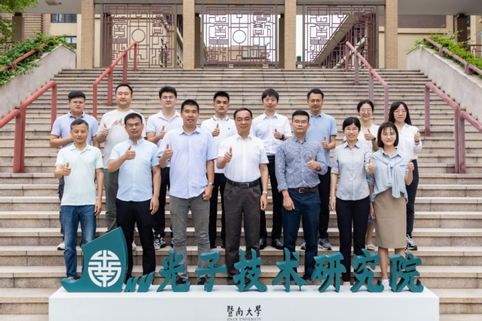
(Guan Baiou and his team members)
In summary, the integration of fiber optic technology into chemotherapy represents a significant advancement in the fight against cancer, potentially transforming how anti-tumor drugs are delivered and utilized in clinical settings. The hope is that this approach will lead to better therapeutic results and improved quality of life for cancer patients worldwide.
For more information, please refer to:
https://news.sciencenet.cn/htmlnews/2024/11/533868.shtm
Jinan University's Ten Thousand Talents Program Pioneers Co
NEWS
- About the University
- Quick Links
Copyright © 2016 Jinan University. All Rights Reserved.




